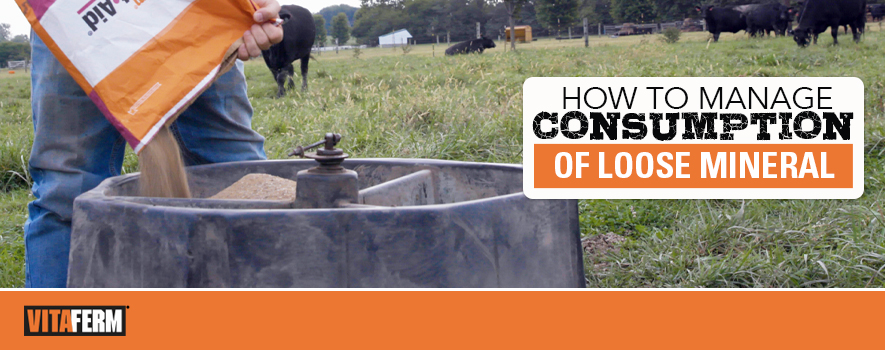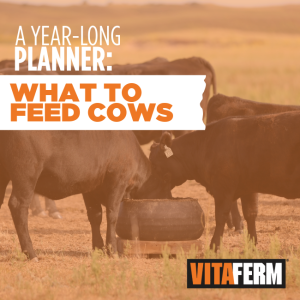Loose mineral has definite advantages in your cow-calf enterprise. It is a cost-effective way to supplement your cow herd, ensuring they receive the nutrients they need. However, too few vitamins and minerals won’t get the job done; and too much of a good thing will cost you, the producer, more than you budgeted for in your nutrition program. There are proper steps to take to regulate the mineral consumption, so your cows and your checkbook all have a positive outlook.
Know your Consumption Levels
Before you try to start regulating consumption levels with various management practices, read the label and know the expected consumption levels of the mineral you are feeding. For example, the VitaFerm® Concept•Aid® Protein Meal has a recommended feeding rate of 1 pound per head per day, whereas the VitaFerm Concept•Aid 5/S has a recommended feeding rate of only 4 oz. per head per day. That is a significant difference.
Once you know your consumption rate, calculate how many bags of mineral you will need to put out each week, based on the number of cows in your pasture. Let’s assume that our pasture has 50 cows, and we will look at the Concept•Aid Protein Meal first with a rate of 1 pound per day.
50-lb. bag / 1 lb. per cow per day x 50 feedings/50 cows = 1 bag per day/50 cows x 7 days =
7 bags/week
Next, let’s assume we have 50 cows and it is closer to calving, so we switch to Concept•Aid 5/S at a rate of 4 oz per day.
50-lb. bag / 4 oz per cow per day = 200 feedings/ 50 cows= 1 bag for 4 days/50 cows or
less than 2 bags/week
You can see there is a big difference in consumption just based on recommended intake, so if you have switched mineral programs, pay attention to the label, follow directions and closely watch intake the first few weeks, while your cows get acclimated to their new products.
Managing for Consumption Challenges
Overconsumption is a genuine concern for most producers because they are watching their expenses with every bag of mineral they pour into their feeder. However, from a nutrition and production standpoint, underconsumption should be a bigger concern.
“We are trying to eliminate a deficiency, so from a nutritionist’s standpoint, underconsumption is a bigger concern because of its negative effects on the economics leading to open cows and decreased health. We really want to ensure the cows consume close to the recommended daily amount of mineral. I would recommend producers not to think about mineral consumption as a fixed number but more of an average over the course of a week,” said Kevin Glaubius, Director of Nutrition at BioZyme® Inc.
To think about the consumption as an average, Glaubius said they will probably eat more than they should when they are first introduced to the mineral; then they will taper off and perhaps eat less later. So, they might get all their required nutrients in the first 4-5 days, and that is ok. However, he said it is not good if they empty out the mineral feeder after 1 or 2 days.
Regardless if overconsumption or underconsumption of your loose mineral is a concern, Glaubius offers three simple management strategies to level out mineral intake.
- Evaluate location of the feeders. <p>If your cattle are under consuming mineral, chances are the cows haven’t found the mineral feeders yet. Move the feeders to a location where cattle congregate on a regular basis – closer to their water sources, under the shade or along the pathways to water or shade.<p> Likewise, if the cattle are going through the mineral faster than you think they should, move the feeders away from the beaten path. Put them further away from the water source or even an extra 100 feet off their routine path between water and shade, so they have to seek the feeders out.
- Cows crave salt too. <p>Yes, cattle will actively seek out salt, and they typically prefer it to other flavors. If your mineral isn’t getting consumed, and you have another salt source in your pasture, either a salt block or loose salt, remove it from the mix. Most VitaFerm mineral contains an adequate amount of salt to balance out the sodium content cattle need. Removing the other sources will cause cows to seek out the salt in the mineral.<p> If your mineral is overconsumed, then you need to consider adding additional salt to your mineral, Glaubius said. He recommends mixing 10 pounds of loose salt per 50 pounds of loose mineral by pouring the loose salt over the mineral in the feeder and mixing it by hand. He does not recommend a salt block as an adequate alternative, as cows can typically only get about .5 ounce of salt per day from a salt block, so it isn’t very effective at controlling mineral intake. <p>“The thing producers need to be careful of is if you mix one ounce of salt in with four ounces of mineral, you are now up to five ounces of consumption and not four. Target consumption has to become five ounces, so they get their four ounces of mineral,” he said.
- Use Proper Feeders. <p>Most mineral feeders having a stocking rate of 30-50 head per feeder. Make sure you know how many your feeder can handle. If your cattle are under consuming, add a feeder, due to the cow pressure on existing feeder(s). If they are over consuming, remove a feeder.<p>Even the type of feeder can influence consumption. If you’ve moved cows from a pasture with an open feeder to one with a black rubber flap lid, that might deter the cows for a few days. Some producers will even remove the flaps until the cows are accustomed to the feeders. Remember, those black rubber flaps attract sunlight, which makes them hot, so consider putting that kind of feeder under a shade source or painting the lid a lighter color, so it doesn’t attract and put off so much heat.
Having an adequate mineral program is one of the keys to your success in the cow-calf business. Regulating mineral intake is one way to make sure that your cow herd receives the nutrients they need, and you don’t break the bank. Always read and follow label directions and follow these three easy steps to make sure your herd is on the right nutrition path to success.




